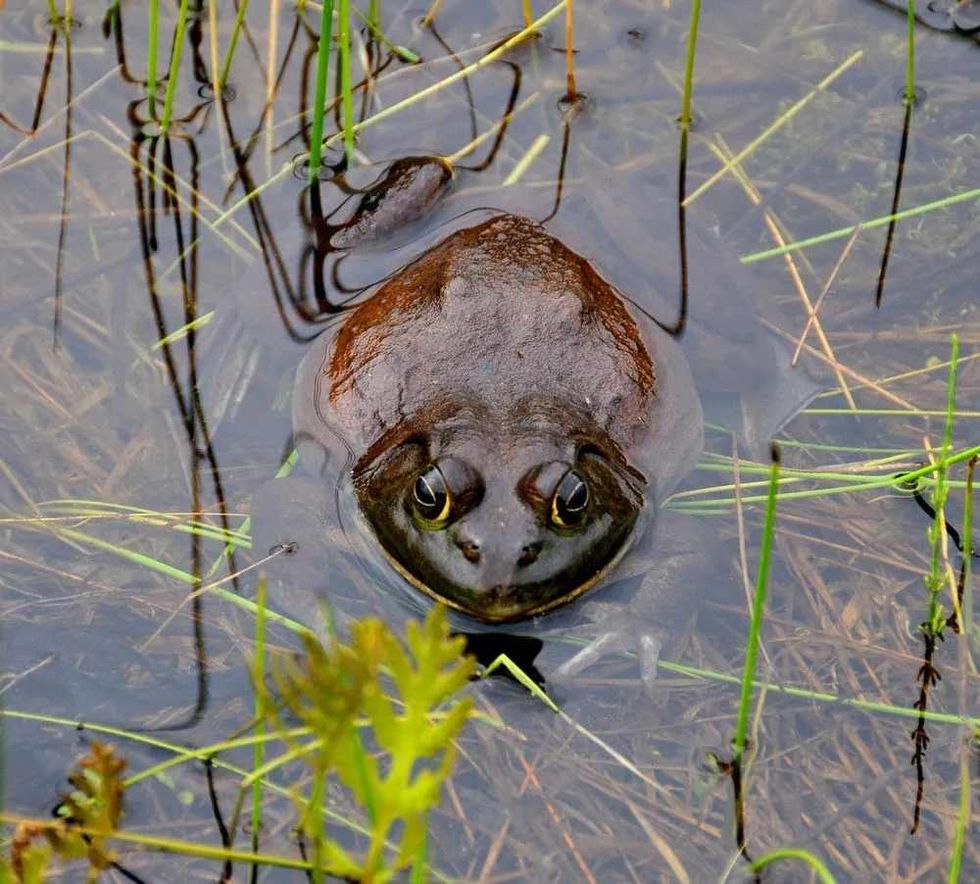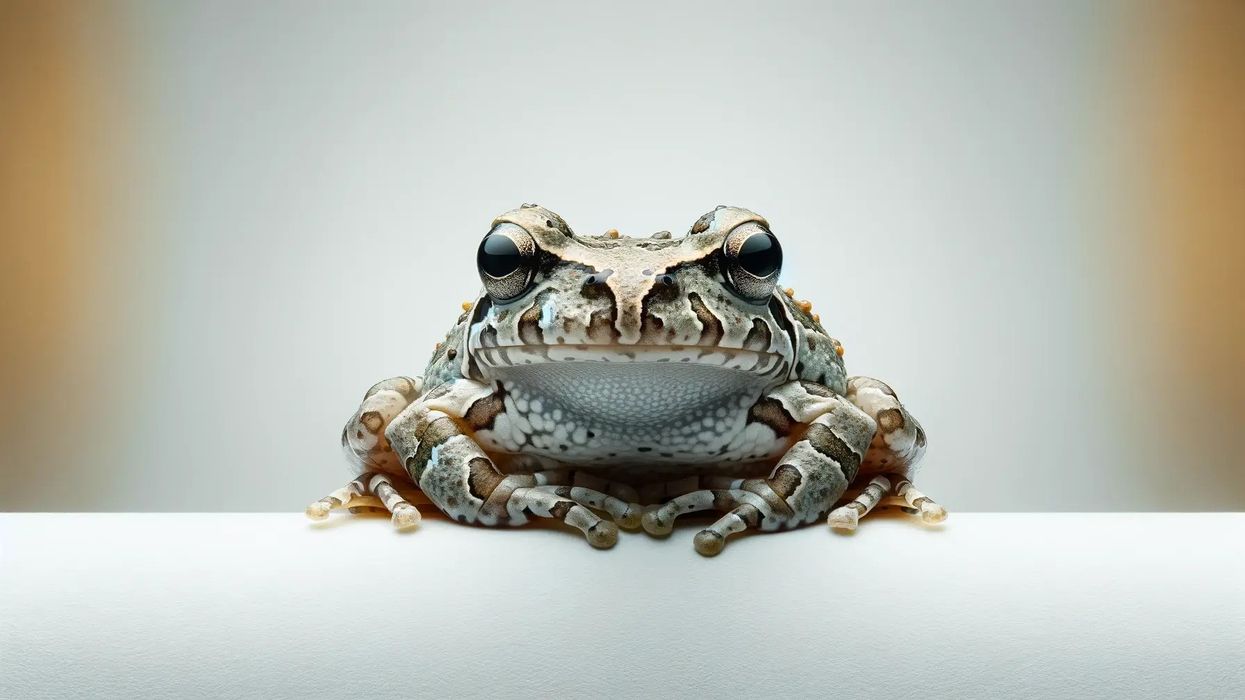The goliath frog (Conraua goliath) is the largest species of frog in the world as they can extend to 12.5 in of length and usually weigh around 7.2 lb. The male goliath frogs are larger than the female goliath frogs. The green-colored goliath frogs have granular skin and appearance.
A mix of yellow and orange color can be seen on their undersides. Goliath frog (Conraua goliath) are found in the areas of Cameroon and Guinea near waterfalls and rivers.
They sit and wait for their prey on the nearby rocks and logs. Their diet includes food just like the other frogs. The tadpoles are independent and dine only on plants near the waterfalls and rivers.
Let’s have a look at some of the interesting goliath frog facts for kids. After reading about goliath frog interesting facts, do check out our articles on marine toad and pool frog as well.
Goliath Frog Interesting Facts
What type of animal is a goliath frog?
Goliath frog (Conraua goliath) is a type of frog that is also known as goliath bullfrog or giant slippery frog. They can grow large in size and have a relatively small habitat range in Cameroon and Equatorial Guinea.
What class of animal does a goliath frog belong to?
Goliath frog belongs to the class of Amphibians. Frogs belong to this class of animals and these amphibians lay their eggs in the nest instead of giving birth to young one's directly.
How many goliath frogs are there in the world?
There is no accurate information and number as to how many goliath frogs are there in the world. Goliath frogs come under the category of endangered species, so their population is decreasing day-by-day.
Where does a goliath frog live?
Goliath frogs are found only in the tropical rainforest, and scientists believe that goliath frogs have been in existence for over 250 million years. They are found near rivers and waterfalls where they can create a nest of rocks and gravel.
What is a goliath frog's habitat?
The goliath frog's habitat is the tropical rainforest of central Africa, north of Equatorial Guinea and southwestern part of Cameroon.
Who do goliath frogs live with?
Adult goliath frogs are believed to be social creatures that live in groups and it is called army, colony, or knot. As they do not have a vocal sac, so they remain mute at all times.
How long does a goliath frog live?
Goliath frogs live up to 15 years in the wild, and can live up to 21 years in captivity. They can live for long years depending on their living habits and the other environmental factors, and their surroundings.
How do they reproduce?
The goliath frogs mate during the months of July and August. The male goliath frogs create semi-circular pools near rivers, by use of rocks, stones, and gravel.
They establish dominance and also gain an opportunity to mate. The females lay hundreds of eggs in the nest that are attached to the vegetation on the sandy bottom of the rivers. After the gestation period is over, the tadpoles hatch from the eggs and remain in the nest till the tadpoles are ready to explore on their own.
What is their conservation status?
The conservation status of goliath frogs is endangered as their population is decreasing day-to-day. The total population of the goliath frogs has dropped steadily over the past 10 years and the species are endangered.
Goliath Frog Fun Facts
What do goliath frogs look like?
Goliath frogs are usually big in size. These frogs are considerably bigger than house cats. The male goliath frogs are usually larger than females. The goliath frog’s dorsal side is covered with green-colored skin and has a granular texture, and the underside of the body is yellow-orange colored.
How cute are they?
Goliath frogs are not cute as they look very different. They can be found jumping around damp areas where they survive and feed on their prey.
How do they communicate?
Goliath frogs lack the vocal sac, and it does not produce mating calls. They do not have the ability to make different sounds and vocalizations. They need to hold the mouth open to make a long whistling noise.
How big is a goliath frog?
The goliath frog takes place in the category of the largest frog in the world. The Cameroon’s goliath frog can be bigger than a human foot, with its measures coming up to 14-16 in.
How fast can a goliath frog run?
The goliath frog usually jumps around. The goliath frogs can jump at least 10 ft forward. Goliath frogs are known to the fastest frogs in the world.
How much does a goliath frog weigh?
Goliath frogs weigh around 7.0-7.4 lb.
What are their male and female names of the species?
The goliath frog males are called male goliath frogs and the goliath frog females are called female goliath frogs.
What would you call a baby goliath frog?
A baby goliath frogs are called tadpoles. The tadpoles are of the same size as that of other breeds but grow quickly to a large size.
What do they eat?
The goliath frog eating habits include insects, crustaceans, fish and other types of amphibians. They come out of their habitat in the night and hunt for their food.
Are they dangerous?
No, goliath frogs are not dangerous. They seem to look dangerous because of their appearance but they are not.
Would they make a good pet?
Yes, goliath frogs make a good pet. As goliath frogs are a popular species, they are imported in the United States for the zoos for the pet trade and are even used in frog jumping competitions.
To have goliath frogs as pets, you must ensure that you nurture them with proper care and provide them with the proper food. You should not handle them as they become stressed when you handle them.
Did you know...
Goliath frogs are the largest frog species to be found on Earth. The goliath frogs can leap up to 10 feet far. They are nocturnal animals. The goliath frogs have the ability to catch and eat bats. The goliath frogs hardly reproduce and rarely survive in captivity. They have excellent hearing ability and hear different sounds from far away.
Goliath frogs can swim incredibly fast and catch their prey within minutes by using their long tongues. Their skin has a different and variety of arrangements that allow them to blend in with the environment as effective predators and also escape from predators.
Are goliath frogs endangered?
Yes, goliath frogs are endangered and their population is said to be declining. According to a recent study, it is said that the total population of goliath frogs has dropped by 50% in the last 15 years. There are various reasons that goliath frogs are endangered which include deforestation, climate change, commercial agriculture, and also over-hunting.
Do people keep goliath frogs as pets?
Yes, some people keep goliath frogs as pets in their house as they might like to pet a frog. And some people don’t pet frogs as they might look different because of their appearance.
There are some states where it is illegal to pet a frog without a permit. Frogs can make good pets for the right person if they are handled with care and affection.
Here at Kidadl, we have carefully created lots of interesting family-friendly animal facts for everyone to discover! Learn more about some other amphibians including sucker fish, or skate fish.
You can even occupy yourself at home by drawing one on our Goliath frog coloring page.










